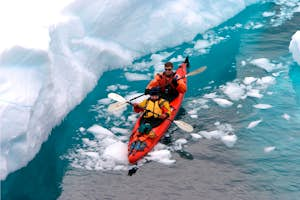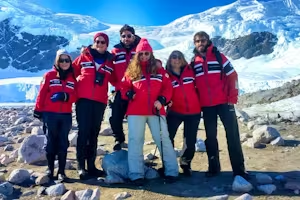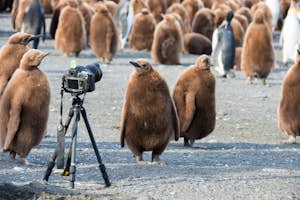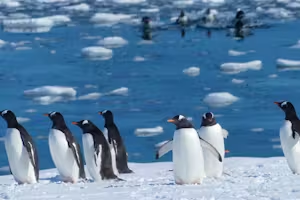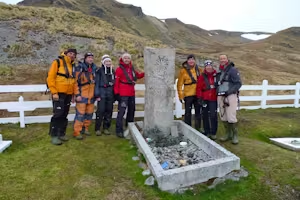What to expect when visiting a penguin rookery
Adelie penguins
A colony of nesting chinstrap penguins
Gentoo penguins in Antarctica
Visiting a penguin rookery is an assault on all the senses. First, the eerie braying cacophony carries on the wind as your zodiac pulls onto the shore. Then the utterly unique and somewhat gut-wrenching smell will hit your nostrils. As the penguins come into view, it's a visual feast as your eyes dance across the colony, trying to decide where to look first.
There's always something to see at a penguin rookery, whatever time of year you visit. In November and early December, the colonies bustle with activity as the birds lay and protect their eggs. Predatory skuas and giant petrels are on the hunt for an easy meal from an unattended nest or a distracted parent-to-be.
In late December, the first chicks begin to hatch and the harried new parents are run ragged as they feed their rapidly growing nestlings. As the chicks grow more independent in January or February, they leave the nests and begin to explore along with newfound friends.
By March many parents are returning to sea for good, abandoning their chicks and forcing them to fend for themselves. The chicks look comical as their new waterproof coat pushes out their downy feathers and their curiosity and hunger lead them into all sorts of scrapes. Meanwhile, some grumpy-looking adults huddle in quiet spots, going through a “catastrophic moult” as they grow in a new set of feathers.
It’s important to give these birds plenty of space as they can’t feed until they’re waterproof again, which may mean weeks without food. For them, staying still and conserving energy is vital.
Top tips for penguin watching
Watching penguins is a favourite activity of the Swoop team when we’re in Antarctica, so we’ve pooled all our top tips to help you make the most of your time with these creatures.
Don’t forget the shoreline
When landing near a rookery, it’s tempting to dash straight to see the penguins and spend the whole time there. However, we also recommend paying attention to the shoreline.
Watching these charismatic creatures indecisively gather, waiting for the perfect moment to dive in, can be hilarious. Even better is witnessing them rocket out of the water on the way back out – especially fun if they’re leaping up onto icy ledges. Photographers can get some brilliant action shots with a bit of patience.

A gentoo penguin dives into the water
Keep your distance
Once you reach the edge of a rookery, it’s essential to stick to International Association of Antarctica Tour Operators (IAATO) regulations and keep a safe and respectful distance from the penguins at all times.
The expedition team will usually plant various crossed flag poles to show where you must not cross, but sometimes you’ll need to use your common sense. You can’t walk through or into the rookery itself, and the key is to avoid doing anything that would alter the penguins’ normal behaviour.
As with all wildlife, the best thing to do is stand quietly and enjoy!

A gentoo penguin rookery
Watch out for the pink snow
When approaching a rookery you’ll start to notice patches of pink snow – please avoid standing in these. Penguin poo is often dyed pink from a key component of their diets: krill. This discolouration of the snow actually helps scientists studying satellite images to find new colonies of penguins from space!
This is one of the reasons you'll need to give your boots a thorough scrub every time you come back aboard to avoid biosecurity contamination from one landing site to the next.

A penguin rookery on the Antarctic Peninsula

Swoop says
You don't need a long lens to get a great shot of penguins in Antarctica, but a little bit of zoom helps to keep you at a safe distance.
Watch the drama in widescreen

Colony of gentoos at Fort Point
We’ve all given in to the temptation of spending entire landings with our eyes welded to the viewfinder of our cameras, but the reality is that if you’re too busy taking pictures, you’re in danger of missing out on the pleasure of seeing the organised chaos that is the whole rookery. When glued to your screen, you have a very narrow field of view and could miss out on high drama happening just a few penguins away.
You don’t need to put your camera away the entire time, but we strongly recommend trying for at least 5-10 minutes per landing. This makes it much easier to be totally present and soak up all the nuances of this unique environment.
Keep an eye out for holes and penguin highways
When heading ashore in Antarctica, you may find strange grooves trodden into the snow. These miniature footpaths are in fact penguin highways, and it’s essential to steer clear of these so penguins can come and go undisturbed.
If you’re visiting during the early season, around November, the holes left by your boots sinking into the deep snow can be a deathtrap for any penguin who falls in and can’t get out. Please follow the pathways marked out by your expedition team to minimise your impact on the site.

Walking with penguins, Cuverville
Penguins you may spot during your expedition
During your time exploring the Antarctic Peninsula, there are three main penguin species to keep an eye out for. Find out more below about individual species and how to identify them.
Gentoo penguins

Zooming on a gentoo penguin
Surprisingly, despite being one of the least numerous penguins in Antarctica overall, the gentoo is the most common species you’re likely to see during your expedition. Nesting on the northern Peninsula’s low hilltops and open beaches, they have some of the most accessible rookeries for visitors to enjoy.
The gentoo is easily identifiable by the white patch above its eye, which wraps around like a pair of large white headphones. These penguins have a distinctive bright orange beak and feet. Measuring 24 inches (61 cm), they’re taller than Adelies and chinstraps, and adults generally weigh around 13 lbs (6 kg).
Gentoo penguins tend to fish within 2.5 miles (4 km) of their nests but can dive up to 495 ft (225 m) – just under half the length of an Olympic-sized swimming pool. Estimates suggest that there are approximately 300,000 breeding pairs in Antarctica, with a further 100,000 found in South Georgia and 70,000 in the Falkland Islands.
Adelie penguins
The iconic Adelie penguin gets its name from the French explorer Jules Durmont d'Urville, who named them after his wife, Adèle. A distinctive white ring around the eye contrasting with a jet-black head makes them easy to identify.
Petite at 23 inches (59 cm) and weighing in at 11 lbs (5 kg) these powerful swimmers have been known to travel up to 62 miles (99.8 km) to feed. Their populations have been pushed further south in the Peninsula as the sea ice, where they prefer to eat, has declined.
These are true Antarctic penguins as they are not found further north, unlike some other species mentioned on this list. There are currently about 2.5 million breeding pairs across the continent’s coastline.

Adelie penguin, Antarctica
Chinstrap penguins
An easy species to identify, this penguin derives its name from the interesting mark around its chin – like the strap of a soldier’s hat. They tend to be a noisy bunch, and often, one individual trumpeting will set off the entire colony.
Like the Adelie, the chinstrap lives throughout the Antarctic Peninsula and the sub-Antarctic regions, with over 1.5 million pairs breeding on the South Sandwich Islands. There are an estimated 8 million pairs in total!
With sea ice reducing, chinstrap colonies are often moving to locations that were previously home to Adelies. Though similar in height to the Adelie at 23 inches (59 cm) they tend to be slimmer at 8 lbs (3.8 kg), about the weight of a large newborn human.

Chinstrap penguin, Antarctica
Penguins you aren’t likely to see
Emperor penguins

Despite being the poster child for polar documentaries, it‘s extremely rare – almost miraculous – to see an emperor penguin when visiting the Antarctic Peninsula on an expedition cruise. The only exception is if you’re travelling on a dedicated voyage to the remote Weddell Sea on a ship with the helicopters needed to reach their rookery at Snow Hill Island.
The penguins you’ll encounter on your Antarctic Peninsula voyage are likely to be one or more of the three species mentioned above.
Standing at 35 inches (90 cm), the emperor penguin weighs up to 88 lbs (40 kg), comparable to the mean average of a 12-year-old human boy. This animal lives in a select, and more difficult to reach, number of locations in Antarctica and the sub-Antarctic islands, including the Weddell Sea, Queen Maud Land, Enderby and Princess Elizabeth Land in East Antarctica and the Ross Sea.
Emperor penguins are also found close to the French research station in Southern Antarctica, near where they spend each winter breeding.
King penguins
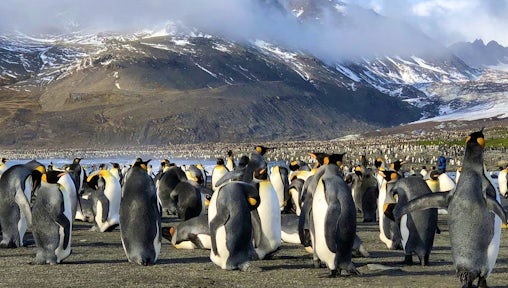
King penguins on South Georgia Island
You’ll only see this colourful penguin in thousand-strong colonies if you’re heading to Subantarctic Islands such as South Georgia.
Closely related to the emperor penguin, the elegant king penguin is the second largest penguin at 25-29 inches (65-75 cm) tall. King penguins have a breeding population of around 1-1.5 million pairs.
Like the emperor penguin, the king lays one egg and both parents carry this around on their feet until it hatches 55 days later. The breeding season lasts 14-16 months, including rearing the chick. This is much longer than other species, which means king penguins only breed twice every three years!
Macaroni penguins

Macaroni penguins at Cooper Bay
Despite being the most numerous penguin species in the world, only a few hundred pairs are found on the Antarctic Peninsula, and it’s rare to spot one there. Like the king penguin, this is another species found mainly in the Subantarctic Islands, where they flourish. This characterful bird is known for its yellow-tasselled plumage, distinguishing it from fellow penguins (although it is similar to the slightly smaller rockhopper penguin).
The astonishing overall number of breeding pairs (11.8 million) is mainly concentrated throughout South Georgia, where you're bound to catch sight of some of the over 5 million couples.
One of the most interesting things about this penguin is its unusual breeding cycle. Two eggs are produced, but the first is 40% smaller than the second. The first is often not fully incubated and is usually lost or removed from the nest before the second hatches. Only one chick is ever raised.
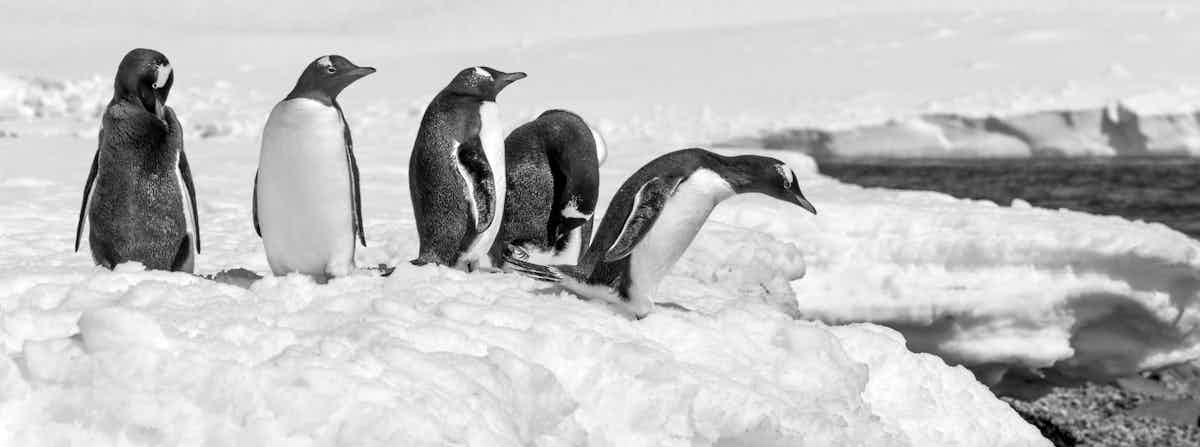
What our customers think of Antarctica's penguins
Review:


